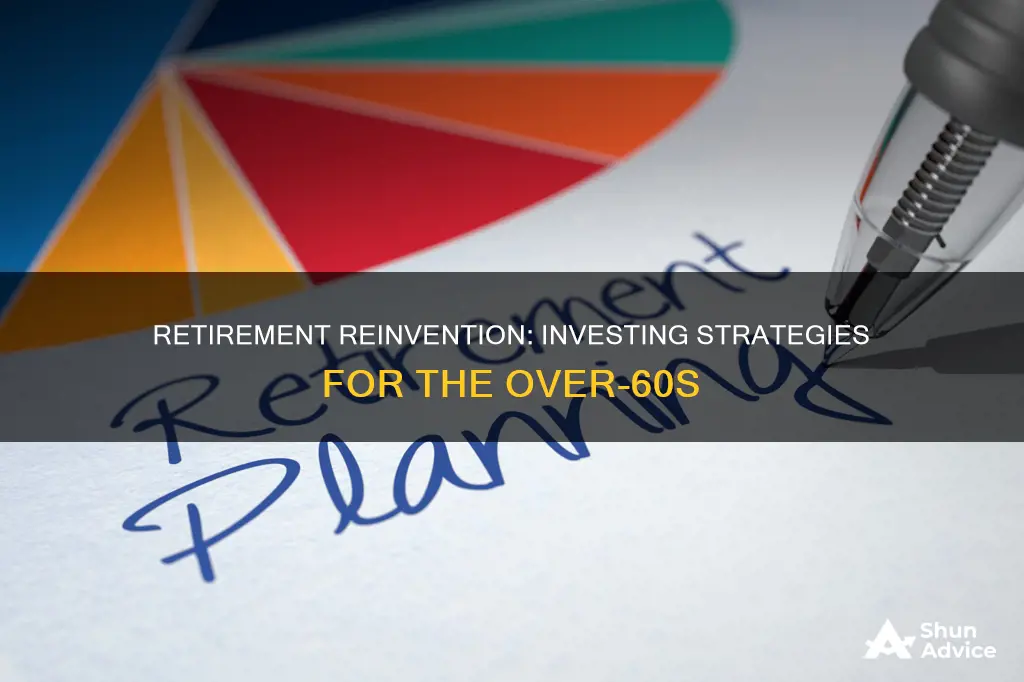
Retirement planning can be challenging, especially for those in their mid-60s and beyond. While it is possible to retire at 60, it requires careful planning and preparation. Here are some essential tips for investing for retirement after 60:
- Diversify your investment portfolio: Spread your investments across different asset classes, such as stocks, bonds, and other investments. This helps to minimize risk and boost performance.
- Know your portfolio's standard deviation: Focus on the standard deviation, which indicates the risk and consistency of returns, rather than just the return on investment (ROI).
- Be mindful of inflation: Consider investing in short-term bonds and investments with high pricing power to protect your portfolio from inflation.
- Focus on high-yield performers: Invest in options like real estate investment trusts, covered calls, and alternative investments to maximize your portfolio's growth as you approach retirement age.
- Understand your retirement financial needs: Work with a financial advisor to determine how much income you will need during retirement, typically advised to be around 70% to 80% of your pre-retirement salary.
- Maximize contributions: Invest the maximum amount in your 401(k) or similar plans to take advantage of pre-tax contributions and tax-deferred growth.
- Consider different investment vehicles: Explore options like a Roth IRA for potential tax benefits and annuities for a guaranteed income stream.
- Decide when to take Social Security: You can start receiving Social Security benefits as early as age 62, but your benefits will be reduced if you start before your full retirement age, which is currently between 66 and 67. Waiting until age 70 will result in the highest possible benefit.
- Sign up for Medicare: Medicare is available at age 65 and can help cover medical expenses, especially if you retire before becoming eligible for Medicare.
- Manage your income and taxes: Take steps to minimize taxes and maximize your income during retirement. Withdrawals from tax-deferred accounts should generally be made when your tax rate is lower.
| Characteristics | Values |
|---|---|
| Retirement age | 60 |
| Retirement income | 70-80% of pre-retirement income |
| Retirement savings | 8-10 times annual salary |
| Social Security benefits | Available from 62 |
| Annuities | Supplement retirement income |
| Investment portfolio | Diversified, conservative asset allocation |
| Inflation | Protect investments with short-term bonds |
| High-yield performers | Real estate investment trusts, covered calls |
| Taxes | Income tax on withdrawals from 401(k) and IRA |
What You'll Learn

Diversify your portfolio
Diversifying your portfolio is a crucial aspect of long-term investment success. This strategy involves holding a range of investments, such as stocks, bonds, and other assets, and then diversifying within each category. Diversification is a hedge against losses and is an effective way to boost performance and reduce risk.
- Stocks and Bonds: Ensure you have a mix of stocks and bonds in your portfolio. While stocks are important at any age, as they have historically posted the best returns, they become even more crucial for older investors. Stocks provide the growth potential needed to counter inflation and ensure your savings don't lose value over time. Bonds, on the other hand, offer more stability and lower risk, which is important as you approach retirement age.
- Diversify Within Asset Classes: Diversification is not just about having different asset classes but also about spreading your investments within each class. For example, with stocks, you can diversify by investing in a range of large-, mid-, and small-cap stocks and funds. This ensures that a loss in one particular stock or industry doesn't significantly impact your overall portfolio.
- Avoid Over-Concentration in Company Stock: Be cautious about holding too much company stock in your portfolio. A significant drop in the value of that stock could severely impact your retirement plans if a large portion of your savings are tied to it.
- Consider Other Investments: Alternative investments, such as precious metals, derivatives, oil and gas leases, and other non-correlated assets, can further reduce the volatility of your portfolio. These investments can also provide returns during periods when traditional asset classes are underperforming.
- Maintain Some Growth Investments: Even as you approach retirement, it's important to maintain a portion of growth investments in your portfolio. This could include equities or real estate, which offer higher returns than more conservative investments. This strategy helps protect against inflation and ensures your savings continue to grow, even if at a slower pace.
- Risk Assessment: As you get older, your risk tolerance may change. Generally, older investors are more risk-averse, focusing more on capital preservation and income generation. Assess your risk tolerance and adjust your portfolio accordingly.
- Consider Annuities: Annuities can provide a guaranteed income stream for life, which is attractive to older investors. They can be funded with cash, IRAs, 401(k)s, and other retirement plans. However, be mindful of the fees and potential lower returns associated with annuities.
- Taxable Accounts: In addition to tax-advantaged retirement accounts, consider saving in a taxable account. This can provide flexibility and improve the tax diversification of your retirement savings.
- Seek Professional Advice: Consult a financial advisor or planner to help you build a diversified portfolio that aligns with your retirement goals, risk tolerance, and time horizon. They can provide personalized recommendations based on your unique circumstances.
Remember, diversification is a key pillar of successful investing, especially as you approach retirement. By spreading your investments across various asset classes and industries, you reduce the impact of any single loss and increase the stability of your portfolio.
Investment Advisor: Helping People Navigate Finances
You may want to see also

Understand standard deviation
When it comes to investing for retirement after 60, it's important to understand standard deviation as a key metric. Standard deviation is a statistical measure of volatility or risk associated with an investment's returns. It indicates how much the returns deviate from the average or "benchmark". This benchmark could be the overall market, a specific index like the S&P 500, or an average of past prices for the same security.
Mathematically, standard deviation is calculated by first finding the mean or average of a set of numbers. The next step is to determine the range of returns by measuring the deviation from the mean. This deviation is then squared for each period, summed up, and divided by the number of periods (known as the variance). Finally, the square root of this sum is calculated, resulting in the standard deviation.
In the context of investing, standard deviation is a valuable tool for investors to assess the riskiness of a stock, bond, fund, or other financial instruments. A larger standard deviation indicates wider swings in returns, while a smaller standard deviation suggests more consistent returns. For instance, if a stock has an average return of 10% and a standard deviation of 5%, its returns would typically fall between 5% and 15%.
Standard deviation is widely used by mutual fund advisory services and in modern portfolio theory. It helps investors make informed decisions by providing insight into the potential volatility of their investments. However, it's important to remember that standard deviation is based on past data, and future returns may vary.
When planning for retirement after 60, investors should consider their risk tolerance and financial goals. Standard deviation can assist in this process by helping investors choose investments that align with their comfort level regarding potential gains and losses. It is one of several tools that can guide investment decisions to ensure a stable financial future.
Retirement Planning: Invest More, Worry Less
You may want to see also

Be aware of inflation
Inflation is one of the biggest risks to your retirement plans. Even low inflation rates can significantly reduce your spending power when you're living on a fixed income. For example, a 60-year-old with $1 million in savings would only have a purchasing power of $531,026 by the age of 85 if inflation averaged 2.5%.
There are several ways to protect your retirement savings from inflation. Firstly, you can delay claiming Social Security benefits. Waiting until you're 70 to start receiving benefits can result in monthly payments that are 77% higher than if you started at 62. This is a good hedge against inflation, but it depends on your health, life expectancy, and other sources of income.
Secondly, you can invest for growth and regularly rebalance your portfolio. In response to inflation and interest rate increases, bond yields have become more attractive, and equities may offer growth that exceeds the inflation rate over time. It's important to periodically rebalance your portfolio to maintain the proper mix of asset classes that match your objectives, time horizon, liquidity needs, and risk tolerance.
Thirdly, consider annuities, which provide a consistent stream of fixed income for life or a specified period. In combination with Social Security, annuities can give you the confidence to pursue a more growth-oriented investing approach with your remaining assets.
Finally, prepare for future long-term care costs. As life expectancy increases, so do the costs associated with old age. Contributing to a health savings account (HSA) or investing in a life insurance policy with a long-term care benefit rider can help offset rising healthcare costs.
While you can't control inflation, taking these concrete steps can help lessen its impact on your retirement security.
Tata Steel: Invest Now?
You may want to see also

Focus on high-yield performers
High-yield performers are an important part of retirement planning for those over 60. This strategy can help you maximise your portfolio as you approach retirement age.
High-yield performers include investments such as real estate investment trusts, covered calls, and alternative investments. These types of investments can help you grow your portfolio more rapidly, ensuring you have sufficient funds to live the life you desire during retirement.
Dividend Yield
When focusing on high-yield performers, it is also important to consider investments with a moderate dividend yield. This can allow you to live off the dividend income while leaving the bulk of your investments in the market. Financial advisors recommend targeting a dividend yield of 2.5%-5%. Higher dividend yields may reduce the amount of money in the market that can grow during upturns.
Annuities
Another option to consider is annuities, which provide a regular income stream for a certain number of years. Annuities can be funded with cash, IRAs, 401ks, and other retirement plans. While annuities offer a guaranteed income, there are complexities to consider, such as high commissions and fees. Additionally, the return on annuities may be lower than that of stock investments, especially after fees are paid.
Other Considerations
When focusing on high-yield performers, it is important to remember that your investment strategy may need to change as you get closer to retirement. Diversification is crucial, and you may need to shift your focus towards consistent yield and limiting risk. Additionally, be mindful of inflation and its potential impact on your investments.
Impact Investing: Social Enterprises
You may want to see also

Plan for healthcare costs
Healthcare costs can be one of the biggest expenses a person faces in retirement. A retired couple aged 65 in 2023 could face long-term medical expenses of approximately $315,000, excluding long-term care, over-the-counter medications, or dental services.
Medicare, which becomes available at age 65, will only cover about two-thirds of your medical costs. It does not cover long-term care, medications, or dental and vision care.
Understand your potential costs
Consider your current health, your family's health history, where you plan to retire, and whether your employer offers retiree health coverage. These factors will impact your potential healthcare costs.
Review your Medicare options
Medicare Parts A and B, known as Original Medicare, cover hospital stays and medical services but do not include vision, hearing, dental care, prescription drugs, or medical care outside the US. You may want to add a drug plan (Medicare Part D) and a Medicare Supplement Insurance Policy (Medigap) to help cover out-of-pocket costs.
Plan for long-term care
Long-term care insurance can help cover the costs of a caregiver or a long-term care facility. This type of insurance can be expensive, so consider purchasing it earlier rather than later. There are also hybrid life insurance/long-term care policies and life insurance policies with long-term care riders.
Consider a Health Savings Account (HSA)
If you have a high-deductible health plan, you can save money for healthcare costs with an HSA. HSA funds can be used to pay for certain medical premiums, including Medicare premiums and long-term care insurance premiums, with tax advantages.
Increase your retirement savings
The more you can earmark for healthcare as you save for retirement, the better. You may need to adjust your financial plan, increase your regular investment contributions, or take on more risk in your portfolio to cover healthcare costs.
The Power of a Paid Website: Why Investing in Your Online Presence is Crucial
You may want to see also
Frequently asked questions
Financial advisors suggest aiming for a retirement income that's about 70% to 80% of your final pre-retirement salary. However, this figure can vary depending on your desired lifestyle, medical costs, and travel plans. As a rule of thumb, some experts recommend having at least 8-10 times your annual salary saved by retirement.
It's important to have a diversified portfolio with stocks, bonds, and other investments. You can also consider investing in real estate investment trusts, covered calls, annuities, and alternate investments. Additionally, explore options like a Roth IRA for potential tax-free benefits and guaranteed income streams.
Maximize contributions to your 401(k) or similar plans, take advantage of catch-up options, and consider adding an IRA. Review your budget and cut down on expenses, and focus on high-yield performers to maximize your portfolio.
In addition to your investment portfolio, consider your desired lifestyle, health care costs, Social Security benefits, and taxes. You may also want to evaluate a phased retirement, where you gradually reduce your working hours and responsibilities.







